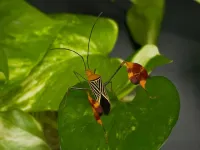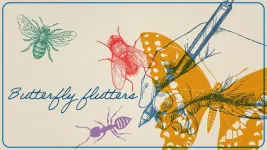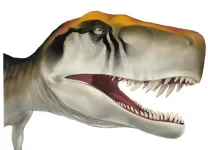(Press-News.org) In the quaint town of Gamboa, nestled near the Panama Canal, a team of scientists embarked on a unique endeavor: attaching red flags onto the legs of crickets and observing how birds respond to them. These eye-catching flags were borrowed from the matador bug (Anisoscelis alipes), an insect renowned for the colorful adornments on its hind legs. This trait has captivated Smithsonian postdoctoral fellow Ummat Somjee for several years, particularly given the matador bug’s tendency to wave them. The persisting question: Why does it wave its colorful hind legs?
A previous study, also supervised by Dr. Somjee, suggested a surprising finding that the fancy leg waving was probably not a sexual display. Some of the most obvious and elaborate traits in animals are used to attract mates and these are predominantly expressed in males; think dances of birds of paradise or an elk’s large antlers. Yet, with matador bugs, both males and females showed off their pretty legs. Also, the waving behavior didn't change whether there were potential mates around or not.
This prompted researchers to explore alternative explanations. Did the waving behavior serve to divert predatory attacks towards their removable hindlegs, increasing their chances of escaping? Alternatively, could the colorful legs be serving as a warning signal to potential predators, alerting them to the bug’s chemical defense or bad flavor? These were the questions asked by Juliette Rubin, currently the Tony Coates Post-Doctoral Fellow at the Smithsonian Tropical Research Institute and lead-author of this study. She had previously spent years understanding how butterflies and moths use elaborate features of their wings to avoid predatory attack, and the matador bugs flags were a mystery ripe for the picking.
This is where the crickets—a popular snack among birds—came into play. Drs. Rubin and Somjee, along with co-authors Jorge Medina and Dr. Jay Falk, observed how predatory birds behaved when presented with true matador bugs and crickets that had matador bug flags attached to their legs. To do so, they used motmots – brilliant, large birds with iridescent feathers, long pendulous tails, and keen eyesight.
Catching the motmots was a whole adventure in and of itself. STRI research assistant Jorge Medina selected a location near the town of Gamboa where the birds were frequently observed and, for several weeks, went into the forest early in the morning to place bird nets.
"We placed the nets in areas of the forest where we saw that the birds moved the most and, when an individual was captured, it was immediately taken to the cages and tested,” said Medina, who spent about a month catching the birds for the experiment. “When the birds were finished with the tests, we released them back in the same area where they were captured.”
The experiment found that predator strikes were not primarily aimed at the hindleg flags, thus discrediting the deflection hypothesis. However, the results supported the chemical defense explanation. Regular crickets were always attacked, but those with flags got fewer hits. Meanwhile, matador bugs were actively avoided, whether they had flags or not, indicating the flags are just one component of their defense strategy.
To support their finding that matador bugs are distasteful prey, the researchers offered crickets and matador bugs to inexperienced chicks – both of which the chicks had never seen before. Again, they found that matador bugs, with or without their flags, seemed to warn these predators to stay away. When the chicks did attack, however, they demonstrated that the bugs were distasteful – shaking their heads and usually refusing to consume another bug. Crickets, on the other hand, were readily attacked and heartily eaten. Their results were published in Behavioral Ecology.
“I was fascinated to see that when we outfitted tasty crickets with the matador bug flags they immediately became less appealing to their bird predators,” said Rubin. “It seems like this warning signal is enough to make the birds cautious, but bugs themselves are so well equipped with ‘don't eat me!’ signals that even without the flags, experienced birds wouldn't touch them.”
This study revealed that the flags signal birds that matador bugs aren't a delectable or safe choice. Yet, these flags collaborate with other aspects of the bug's appearance to emphasize the message, indicating that they are part of a complex defense strategy that has likely evolved over time to protect these bugs from being eaten by birds.
Although focused on a single insect species, this study represents a significant advancement in deepening our comprehension of the evolution of elaborate traits in nature. These findings enhance our understanding of the reasons behind the presence of brightly colored and unusual physical features in certain animals.
The authors involved in the study represent the Smithsonian Tropical Research Institute, the Florida Museum of Natural History, the University of Florida, the University of Colorado, Boulder, and the University of Texas at Austin.
Headquartered in Panama, the Smithsonian Tropical Research Institute is a unit of the Smithsonian Institution in Washington, DC. The institute furthers the understanding of tropical biodiversity and its importance to human welfare, trains students to conduct research in the tropics and promotes conservation by increasing public awareness of the beauty and importance of tropical ecosystems.
END
Red flags: I’m not the bug for you!
2024-04-03
ELSE PRESS RELEASES FROM THIS DATE:
Developing a vaccine for the “zombie drug” xylazine
2024-04-03
LA JOLLA, CA—Xylazine is an FDA-approved sedative and pain reliever for use in animals, but it has severe adverse effects when used in humans. It is now illicitly being added to opioids, like fentanyl and heroin, as well as cocaine—leading to a sharp rise in overdose deaths.
Now, Scripps Research chemical biologists have developed a vaccine to block the effects of xylazine’s toxicity. The vaccine works by training the immune system to attack the drug, which is described in a new paper published in Chemical Communications on April 1, 2024.
“We demonstrated that a vaccine can reverse the symptoms ...
New sunflower family tree reveals multiple origins of flower symmetry
2024-04-03
UNIVERSITY PARK, Pa. — The sunflower family tree revealed that flower symmetry evolved multiple times independently, a process called convergent evolution, among the members of this large plant family, according to a new analysis. The research team, led by a Penn State biologist, resolved more of the finer branches of the family tree, providing insight into how the sunflower family — which includes asters, daisies and food crops like lettuce and artichoke — evolved.
A paper describing the analysis and findings, which researchers said may help identify useful traits to selectively breed plants with more desirable characteristics, appeared online in the journal ...
Lurie Children’s Hospital first in Illinois to treat Duchenne muscular dystrophy with FDA-approved gene therapy
2024-04-03
On March 27, 2024, Ann & Robert H. Lurie Children’s Hospital of Chicago treated its first patient with ELEVIDYS (delandistrogene moxeparvovec-rokl), the first gene therapy for Duchenne muscular dystrophy – a rare, genetic disease characterized by progressive muscle damage and weakness. Lurie Children’s is the first in Illinois to administer this treatment after ELEVIDYS received U.S. Food and Drug Administration (FDA) approval in June 2023.
Developed by Sarepta Therapeutics, ELEVIDYS is approved for the treatment of Duchenne muscular dystrophy (DMD) in ambulatory patients aged 4 through 5 years with ...
Butterflies, bees, ants and flies are the most widely referenced arthropods in a sample of almost 4,000 haiku - which commonly describe their color, flight and ecology
2024-04-03
Butterflies, bees, ants and flies are the most widely referenced arthropods in a sample of almost 4,000 haiku - which commonly describe their color, flight and ecology
###
Article URL: https://journals.plos.org/plosone/article?id=10.1371/journal.pone.0298865
Article Title: Diversity and complexity of arthropod references in haiku
Author Countries: USA
Funding: The author(s) received no specific funding for this work. END ...
Might your personality affect how you move? Runners classified as Myers-Briggs "Sensing" types have a more grounded running style in experiments than those classified as "Intuition" types
2024-04-03
Might your personality affect how you move? Runners classified as Myers-Briggs "Sensing" types have a more grounded running style in experiments than those classified as "Intuition" types
###
Article URL: https://journals.plos.org/plosone/article?id=10.1371/journal.pone.0300108
Article Title: Mind to move: Differences in running biomechanics between sensing and intuition shod runners
Author Countries: France, Switzerland, Belgium
Funding: The author(s) received no specific funding for this work. END ...
Early dinosaurs grew up fast, but they weren’t the only ones
2024-04-03
The earliest dinosaurs had rapid growth rates, but so did many of the other animals living alongside them, according to a study published April 3, 2024 in the open-access journal PLOS ONE by Kristina Curry Rogers of Macalester College, Minnesota and colleagues.
Dinosaurs grew up fast, a feature that likely set them apart from many other animals in their Mesozoic (252 to 66 million years ago) ecosystems. Some researchers have proposed that these elevated growth rates were key to the global success of dinosaurs, but little is known about the growth strategies of the earliest dinosaurs. In this study, Rogers and colleagues performed histological analysis, examining patterns of bone ...
Working outside the typical 9–5 in younger adulthood may be linked with worse health decades later
2024-04-03
The hours you work earlier in life may be associated with worse health years later, according to a study published April 3, 2024 in the open-access journal PLOS ONE by Wen-Jui Han from New York University, US.
Studies have consistently shown that nonstandard work schedules—working outside the traditional nine-to-five workday—can negatively impact physical and mental health as well as social and family life. The current study uses a life-course approach to provide a longer-term perspective on how work schedule ...
Demand for critical minerals puts African Great Apes at risk
2024-04-03
A recent study led by researchers from the German Centre for Integrative Biodiversity Research (iDiv), the Martin Luther University Halle-Wittenberg (MLU) and the non-profit conservation organization Re:wild shows that the threat of mining to the great ape population in Africa has been greatly underestimated. Their results have been published in Science Advances.
The rising demand for critical minerals, such as copper, lithium, nickel, cobalt, and other rare earth elements required for the large-scale transition to cleaner energy is causing a surge of mining in Africa, where a large share of those mineral resources is still unexploited. ...
Tourism to Yellowstone National Park produces more than a billion kilos of CO2 emissions annually
2024-04-03
Tourism to Yellowstone National Park produces more than a billion kilos of CO2 emissions annually, with 90% arising through travel to and from the park, especially from visitors arriving by plane.
####
Article URL: https://journals.plos.org/climate/article?id=10.1371/journal.pclm.0000391
Article Title: Quantifying and evaluating strategies to decrease carbon dioxide emissions generated from tourism to Yellowstone National Park
Author Countries: United States
Funding: This work was supported by the Utah Agricultural Experiment Station (Project ...
Air quality in schools: Shielding kids with intellectual and developmental disabilities from COVID
2024-04-03
During the pandemic, University of Rochester Medical Center (URMC) researchers, including those from the Intellectual and Developmental Disabilities Research Center (IDDRC), teamed up with the Mary Cariola Center to study ways to prevent COVID infection among children with intellectual and developmental disabilities (IDD), a particularly vulnerable population. Together, they found that good airflow and filtration in schools may help these children and their teachers avoid COVID infections.
The COVID pandemic was a particularly difficult balancing act for children with IDDs and their ...









